What is the 4 out 1 in motion offense
The 4 out 1 in motion offense is a basketball offensive strategy that creates scoring opportunities via a variety of sequences such as basketball cuts, basketball screens, and dribble drive action.
What is an example of the initial formation for the 4 out 1 in motion offense
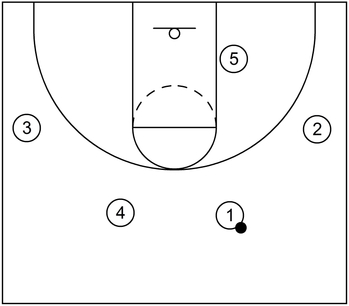
The 4 out 1 in motion offense is typically initiated with two players in the slot areas near the top, two players on the wings, or the corners in some instances, and another player near the low post area.
In reference to traditional basketball positions, the players near the slot could be representative of the team’s point guard and power forward, typically denoted as the numbers 1 and 4.
The players on the wing could be representative of the team’s shooting guard and small forward, usually denoted as the numbers 2 and 3.
Also, the player near the low post block could be representative of the team’s center, generally denoted as the number 5.
What are general principles for the 4 out 1 in motion offense
The general principles that players should consider when executing the 4 out 1 in motion offense are to create good spacing, take high percentage shots, and play to their respective strengths.
Create good spacing
Generally speaking, players should be about 12 to 15 feet apart from each other to create good spacing. By doing this, players will have better opportunities to cut to the basket or dribble into the lane for potential scoring opportunities.
Take high percentage shots
Players should take high percentage shot attempts and players should not force low percentage shots.
If a player is not open to take a high percentage shot, then that player should pass the ball to another teammate and cut or screen, which could create more opportunities to score.
Play to strengths
Generally speaking, players should play to their respective strengths while minimizing or de-emphasizing potential offensive flaws or deficiencies.
For example, if a player is one of the team’s best perimeter shooters, then that same player should always look to take perimeter jump shots when open.
Conversely, if a player is not necessarily one of the team’s best shooters, but is great at cutting to the basket or driving to the lane, then that player should try to execute those particular actions if the opportunity presents itself to do so.
Also, if a post player is one of the team’s best screeners or one of the team’s best low post scorers, then those particular players should try to execute those actions whenever possible.
Affiliate Disclosure: I may earn a commission on qualifying purchases made through the links below.
What are general rules for players within the 4 out 1 in motion offense
These are general rules for the players, primarily derived from insights within The 4 Out 1 In Motion Offense by Jay Wright.
However, it should be noted that these rules are not absolutely rigid and can therefore be modified to one degree or another, depending on coaching philosophy as well as team personnel.
Post players should try to stay opposite of each other
Generally speaking, the post players should try to stay opposite of each other on both sides of the court. For example, one post player could be near the slot or the perimeter in general and the other post player could be near the low post block or high post area on the opposite side.
In another example, one post player could be near the low or high post area while the other post player is near the opposite wing or corner. Either way, the main emphasis is that the two post players should try to remain opposite of each other whenever possible.
Post players should primarily set screens for perimeter players
Post players should primarily set on-ball screens or off-ball screens for perimeter players, particularly near the slot or on the wing area.
At the same time though, post players should generally try to minimize basketball screens for other post players, especially near perimeter areas of the court.
Wing players with the ball should look to feed the post
When the ball gets passed to the wing, particularly from the slot and there is a low post player on that same side, the wing player should try to execute a post entry pass whenever possible.
Post players with the ball near the low post should look to score
When a post player near the low post area receives the ball from the wing, that same player should try to score quickly with a low post move if it makes sense to do so.
In other words, if the defensive team does not execute double team action or if there is a size/skill advantage over the post defender, then the post offensive player should look to shoot the ball quickly and with confidence.
Wing players should cut after feeding the post
After the low post player receives the ball from a player on the wing, that same wing player should cut as opposed to just standing still.
Preferably, wing players should consider cutting through to the basket to potentially receive the ball again for a scoring opportunity at the rim or if that is not available, then wing players should continue to cut through to the opposite corner.
Also, if the post player is not open to score, then that player could pass to the teammate cutting to the basket or possibly to another teammate on the perimeter, particularly near the same side wing or perhaps on the opposite wing via a skip pass, in some instances.
Slot players with the ball should cut or screen after executing a pass
When a slot player executes a pass to the wing or opposite slot, that same slot player should execute a cut, usually towards a corner, or set a screen, typically away from the ball.
In other words, a slot player should stay in motion via pass and cut action or pass and screen away action.
Also, if a slot player is a guard, then that same slot player should typically avoid setting screens for post players.
Slot or wing players could drive to score or kick
If a slot player receives the ball from another teammate, then that same slot player could dribble drive into the lane if a pass to the wing is not available or if an on-ball screen does not occur.
Afterwards, once the slot player drives into the lane, that player should look to shoot if open or execute a kick pass to another teammate on the perimeter, who could also shoot if open.
Additionally, this type of action applies to a player near the wing as well. Basically, when a wing player receives the ball from a teammate, that same player could dribble drive into the lane if the pass to the low post player is not available or on-ball screen action does not happen.
Following that, the wing player that drives into the lane could either take the mid-range shot, try to score via a floater in the lane, or execute the kick pass to another teammate.
Slot or wing players should look to shoot high percentage shots if open
Whenever a player in the slot or on the wing receives the ball from another teammate, that same player should have their eyes on the rim looking to take the perimeter jump shot within applicable shooting range if it is open.
Conversely, if the jump shot is not available, then that slot/wing player could execute one of the alternative actions such as attacking the rim, receiving an on-ball screen, feeding the low post, or passing to another perimeter teammate.
Post players could set an on-ball screen as a counter to pressure defense at the top
If the on-ball defender executes pressure defense against the player in possession of the basketball at the top or near the slot several feet away from the three-point arc, then one of the post players could set an on-ball screen such as a flat screen or angled ball screen to act as a pressure release.
Afterwards, the non-screening post player could either pop to the corner (preferably the opposite corner) or replace at the top if the screener rolls to the basket, which is also known as roll and replace action.
What is an example of low post scoring options within the 4 out 1 in motion offense

This is a basic example of the 4 out 1 in motion offense that features a slot to wing pass and a low post feed for scoring opportunities. To start, 2 receives the ball from 1 and then 5 receives the ball from 2.
At the same time as that action occurs, 3 and 4 interchange spots on the weak side. Next, 2 cuts to the basket while 3 cuts to the right side wing via the screen set away from the ball by 1.
Following that, 5 could score with a low post move. If that is not available, then 2 could receive the ball from 5 and score near the basket or 3 could receive the ball instead and take the open jump shot.
What are examples of quick hitters for the 4 out 1 in motion offense
Example 1 – Part 1
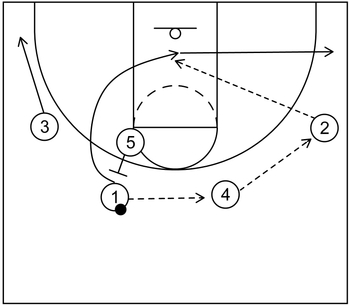
This is an example of a quick hitter within the 4 out 1 in motion offense that contains elements of the Chin series from the Princeton offense followed by a down screen towards the corner, also known as a wide pin down screen.
To start, 4 receives the ball from 1 and after that, 2 receives the ball from 4. Next, 1 cuts to the basket via the back screen set by 5, receives the ball from 2, and then scores near the rim.
However, if 1 is not open, then 1 continues the cut out towards the right side corner. Also, as that action happens, 3 cuts down to the left side corner.
Example 1 – Part 2
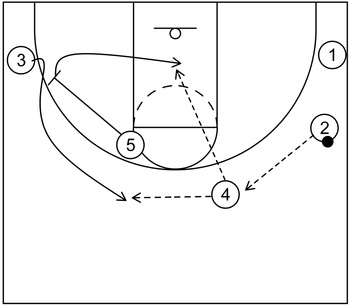
Following that, 4 receives the ball from 2 and as that happens, 3 cuts up to the left slot by way of a wide pin down screen set by 5. Next, 3 could receive the ball from 4 and take the jump shot if open.
Also, as an alternative option, 5 could cut to the basket after setting the screen, duck into the lane, receive the ball from 4 via high low action, and then quickly score at the rim.
Example 2 – Part 1
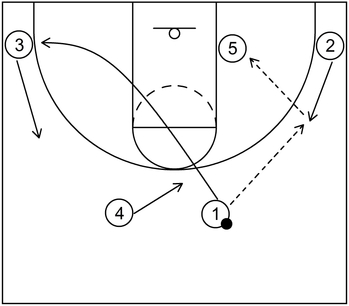
This is an example of a quick hitter within the 4 out 1 in motion offense that includes scoring opportunities near the basket or near the perimeter.
It is based on insights from Man-to-Man Side Ball Screen Offense with Quick Hitting Plays by Billy Donovan.
To start, 2 cuts to the right side wing from the adjacent corner to receive the ball from 1. Afterwards, 5 could receive the ball from 2 if that is open and score near the basket via a low post move.
Also, as that occurs, 1 cuts through to the left side corner while 3 lifts up to the left side wing. At the same time, 4 cuts to the top from the left slot.
Example 2 – Part 2
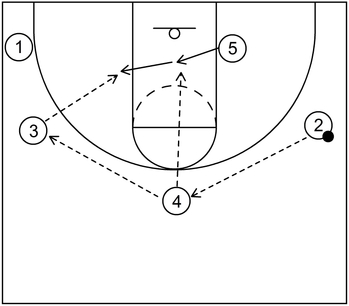
If 5 does not receive the ball from 2, then 4 receives it instead at the top. Following that, 5 ducks into the lane and could receive the ball from 4 via high low action if that is available.
If the high low action is not there, then 3 could receive the ball from 4 instead. Next, 5 could cut across the lane to the left side low post, receive the ball from 3 if possible, and then score via a low post move.
Example 2 – Part 3
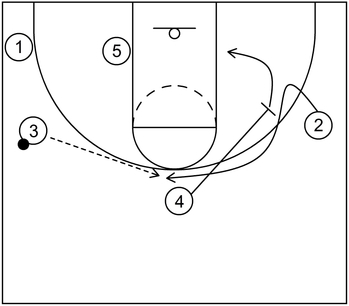
If 5 does not receive the ball from 3, then 2 could set up their defender and cut to the top via the wide pin down screen set by 4. Afterwards, 2 could receive the ball from 3 and take the three-point jump shot if open.
Furthermore, 4 could cut to the right side low post for a potential offensive rebound as well.
Example 2 – Part 4
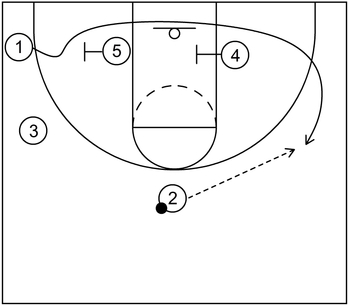
If 2 is not open, then 1 could cut to the right side wing via baseline screens set by 5 and 4. From there, 1 could receive the ball and take the three-point jump shot if open.
What are examples of ball screen scoring options within the 4 out 1 in motion offense
Example 1 – Part 1
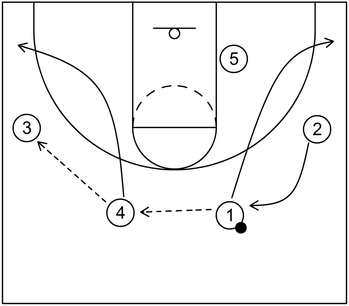
This is an example of the 4 out 1 in motion offense that includes a slot to slot pass, which eventually leads to pick and roll action near the wing.
To begin, 4 receives the ball from 1 and afterwards, 1 cuts through to the right side corner. As that happens, 3 receives the ball from 4 and following that, 4 cuts to the left side corner.
Example 1 – Part 2
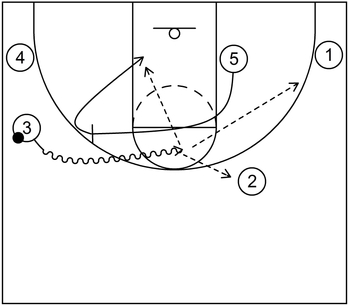
Next, 3 dribbles into the middle of the court via the on-ball screen set by 5. Afterwards, 5 rolls to the basket.
From there, 3 could take the open jump shot or pass the ball to other teammates who could take open jump shots or score near the rim.
Example 2 – Part 1
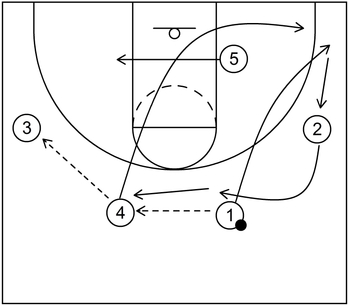
This is a simple example of the 4 out 1 in motion offense that demonstrates a slot to slot pass, which leads to pick and roll action. To start, 4 receives the ball from 1 and after that, 1 cuts through to the right side corner.
Next, 3 receives the ball from 4 and after that, 4 also begins to cut through to the right corner. This triggers 5 to make an automatic cut across the lane to the left side low post block.
At the same time, 2 cuts from the wing to the left slot while 1 fills the right side wing area.
Example 2 – Part 2
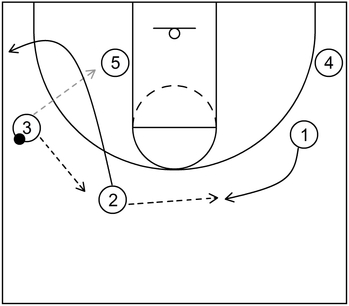
Next, 5 could receive the ball from 3 if that is available, represented by the gray arrow. Otherwise, 2 receives the ball from 3 and then 1 cuts to the empty right slot to receive the ball from 2.
Also, after making the slot to slot pass, 2 cuts away to the left side corner.
Example 2 – Part 3
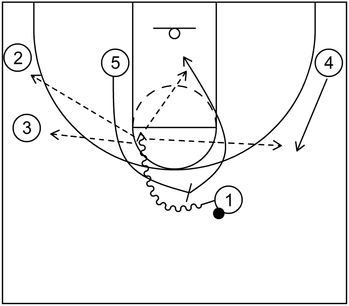
Next, 1 dribbles toward the lane via the on-ball screen set by 5 who also rolls to the basket. At the same time, 4 could lift up towards the right side wing.
From there, 1 could pass to any of the open perimeter players who can take jump shots or 1 could pass to 5 who could score near the rim.
Example 3

This is an example of the 4 out 1 in motion offense that shows a shallow cut into a flat ball screen, which could be used as a counter to on-ball pressure defense. To start, X1 pressures the ball handler several feet away from the three-point arc.
This triggers 4 to execute a shallow cut followed by a flat ball screen near the mid-line of the court.
After that, 1 dribbles toward the basket near the left side and 4 rolls to the rim. Also, 3 drifts to the left side corner while 5 pops out to the right side short corner.
Following that, 1 could pass to the perimeter shooters or 5 could receive the ball near the basket instead.
Example 4
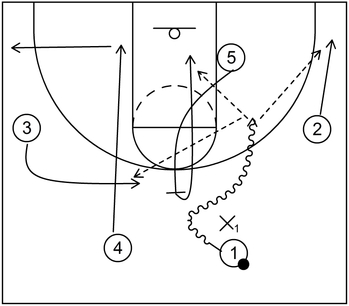
This is an example of the 4 out 1 in motion offense that demonstrates another flat ball screen. However, this time, the screening action comes from the low post player.
To start, X1 pressures the ball handler near the top and that triggers 5 to execute a flat ball screen near the mid-line of the court.
Also, as that happens, 4 quickly cuts down and out to the left side corner. Next, 1 dribbles toward the screen but rejects it and then dribbles toward the basket near the right side of the floor.
At the same time, 5 rolls to the basket, 2 drifts down to the right side corner, and 3 lifts up to the left slot area.
From there, 2 or 3 could receive the ball from 1 and take three-point jump shots if open. Additionally, 5 could receive the ball from 1 and score near the rim.
Example 5

This is an example of the 4 out 1 in motion offense that features the flat ball screen once again. However, this time, the non-screening post player will replace at the top.
To begin, 4 executes a shallow cut into flat ball screen as previously. Next, 1 dribbles toward the basket near the left side and as soon as 4 begins to roll to the basket, 5 replaces at the top near the right slot.
Also, 3 drifts down to the left side corner. From there, 3 could receive the ball from 1 and take the jump shot if open or 4 could receive it and score near the rim.
Example 6
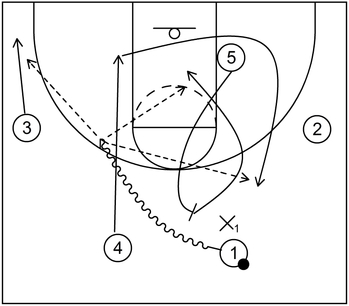
This is an example of the 4 out 1 in motion offense that demonstrates roll and replace action. However, this time, the screening action comes from the low post player.
To begin, 5 lifts up to set the angle screen near the top. This triggers 4 to cut down towards the left side low post. Next, 1 dribbles toward the basket near the left side and then 5 rolls to the basket.
As that roll action occurs, 4 replaces at the top near the right slot while 3 drifts down to the left corner. From there, 5 could receive the ball and score near the basket.
Also, 3 or 4 could receive the ball and take three-point jump shots if open.
Example 7 – Part 1
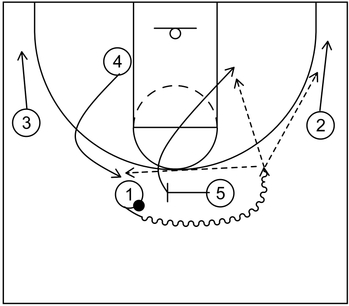
This is an example of action within the 4 out 1 in motion offense that features a ball screen and stagger screens. To begin, 1 dribbles toward the basket via the on-ball screen set by 5.
As that occurs, 5 rolls to the right side low post block while 4 replaces at the left slot. Furthermore, 2 and 3 drift down to the corners.
From there, 5 could receive the ball near the low post block and score with a post move. Also, as alternative options, 2, 3, or 4 could receive the ball instead and take the open jump shot from behind the three-point line.
Example 7 – Part 2
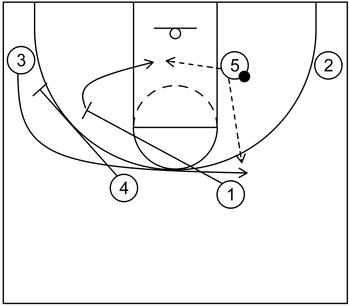
If 5 receives the ball, but the opportunity to score is not there, then 3 could cut to the top near the right slot via stagger screens set by 1 and 4. Next, 3 could receive the ball from 5 and take the jump shot if open.
Also, as another scoring option, 1 could cut to the basket after setting the screen, receive the ball from 5, and score at the rim.
Example 8 – Part 1
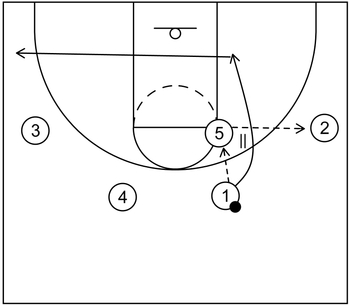
This is an example of action within the 4 out 1 in motion offense that features a hand-off near the high post followed by a side ball screen. To begin, 5 receives the ball from 1 and following that, 1 cuts to the basket.
5 executes a hand-off with 1 who could score near the basket. If 1 does not receive the ball from 5, then 1 could cut through to the left side corner. After that, 2 could receive the ball from 5.
Example 8 – Part 2

Next, 2 dribbles towards the middle of the floor near the free throw line via a side ball screen set by 5. After that, 5 rolls to the basket and 2 could pass the ball to any of the other teammates for possible scoring opportunities.
What is an example of transition offense that flows into 4 out 1 in motion offense
Part 1
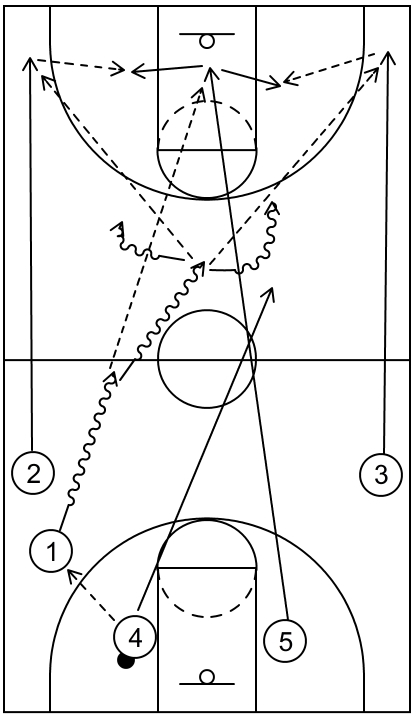
This is an example of transition offense that eventually flows into 4 out 1 in motion offense scoring options with dribble drive elements.
The diagrams initially demonstrate full court primary break scoring options and then flows into half court scoring options during secondary break action.
It is derived from insights within Offensive System by Nathan Davis and the main objective is to score quickly during the primary or secondary break before the defense is fully prepared to stop the potential offensive attack.
It should also be mentioned that the initial transition phase very similar to the numbered fast break. In other words, each of the five offensive players should typically fulfill certain roles.
More specifically, 1 should primarily pass into the frontcourt as quickly as possible. 2 and 3 should generally sprint to the corners. Either 4 or 5 can grab defensive rebounds if the opposing team misses the shot or execute the inbound pass if the opposing team makes the shot.
Also, at the same time, the post player that did not grab the defensive rebound or inbound the ball runs to the rim.
To begin, let’s say that the opposing team misses a shot and that leads to a defensive rebound gathered by 4.
As a side note, if the opposing team made a shot, 4 would simply catch the ball as it goes through the basket ring and execute the inbound pass as mentioned previously.
Next, 1 should cut towards the free throw line extended area on the strong side with their back towards the sideline, preferably at an angle.
Following that, 1 should receive the ball from 4 via an outlet pass while 2 and 3 sprint to the corners. Also, as that occurs, 5 should run to the rim as quickly as possible.
Next, 1 could dribble once or twice towards the frontcourt to improve passing angles if necessary.
From there, 5 could receive the ball from 1 as the first scoring option during transition and then 5 could score at the basket with a layup or dunk.
If 1 is not able to pass to 5, then 1 could dribble once more into the frontcourt.
After that, 2 or 3 could receive the ball from 1 as the second scoring option during transition and then 2 or 3 could take jump shots, preferably, three-point jump shots.
If 2 or 3 receives the ball from 1 but the jump shot is not available, then 5 could establish position near the low post block on the strong side.
From that point, 5 could receive the ball from 2 or 3 via a entry pass into the post and then 5 could score near the basket with a low post move as the third scoring option during transition.
Furthermore, if 1 cannot pass the ball to any other teammates, then 1 could try to drive towards the basket on either side of the floor.
From there, 1 could become the fourth scoring option during the transition and take the mid-range jump shot or continue to drive downhill for a possible layup or dunk at the rim.
Additionally, while all of that happens, 4 trails the play and eventually settles near a slot that is opposite of 1.
Also, when 4 trails the play, at least in this instance, this allows 4 to act as a defensive safety, particularly if 1 executes a live-ball turnover or any other player takes a quick shot, misses that shot, and the opposing team gathers a defensive rebound.
In other words, 4 should be able to get back to protect the basket during transition defense instead of the opposing team getting a free, uncontested layup or jump shot during their transition offense phase.
Part 2
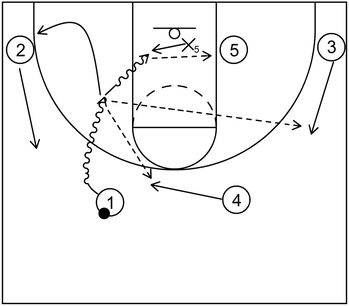
Next, let’s say that 1 decided to drive towards the basket, particularly from the left slot, if no other options were available. When that occurs, 3 could cut to the right side wing, receive the ball from 1, and take the jump shot if that is open.
As another possible option, if 1 is able to drive very close to the basket, 1 could possibly score via a layup or dunk as mentioned before. Otherwise, if X5 slides over to provide help defense, then 5 could receive the ball from 1 and then score at the rim.
Alternatively, if 1 is not able to drive closely to the basket, then 4 could cut to the top, receive the ball from 1 via the pitch back pass, and take the jump shot if that is open.
If 4 receives the ball but does not take the jump shot, then 1 could fill the left side corner while 2 fills the empty left side wing area.
Part 3
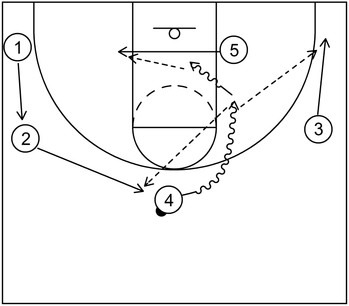
After that, 4 could dribble drive towards the basket and while that occurs, 5 should cut across the lane to the left side low post area.
Moreover, 3 should cut back to the right side corner while 2 fills the top area and 1 fills the vacant left side wing.
Next, 4 could possibly score via a mid-range jump shot or layup at the rim.
Furthermore, 5 could receive the ball from 4 and score near the basket or 3 could receive it instead for a potential three-point jump shot.
Alternatively, 2 could receive the ball from 4 and possibly take the jump shot if that is open.
Part 4
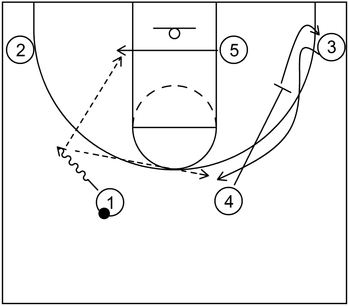
Here is an additional scoring option that does not involve dribble penetration towards the basket by 1.
Instead, 1 could simply dribble towards the left side wing, which is also a dribble entry, and when that occurs, 5 could cut across the lane to the left side low post block.
At the same time, 3 could cut to the right slot area via the wide pin down screen set by 4. Also, 4 could fill the vacant right side corner after setting the wide pin down screen.
Next, 5 could receive the ball from 1 and score near the basket, primarily via a low post move. As another scoring option, 3 could receive the ball from 1 and take the three-point shot if open.
Part 5
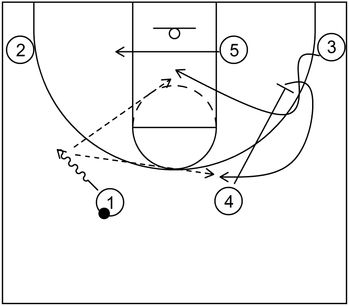
Here is yet another potential scoring option that could be implemented if 1 does not execute dribble drive action towards the basket.
Starting off similar to the previous diagram, 1 dribbles toward the left side wing. After that happens, 5 could cut across to the left side low post area. Next, 3 could execute a curl cut to the basket via a wide pin down screen set by 4.
Additionally, 4 could execute a self replace cut back to the right side slot area. From there, 3 could receive the ball from 1 and score at the rim. Alternatively, 4 could receive the ball instead and take the jump shot if open.
What is an example of a basketball drill for the 4 out 1 in motion offense
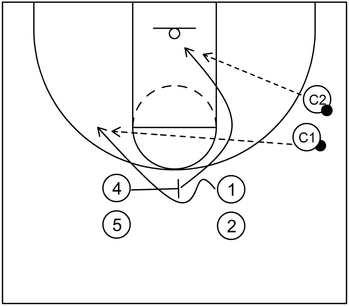
This is an example of a basketball drill for the 4 out 1 in motion offense that seeks to develop screening, shooting, and cutting.
It is based on insights within Breakdown Drills for the 4-Out 1-In Motion Offense by Jay Wright.
In terms of the setup, offensive players in the line near the right slot should be perimeter players while players in the left slot should be post players.
Also, there should be two additional coaches with possession of basketballs, indicated by the letter C1 and C2 near the right side wing. However, if coaches are not available, it is possible to utilize team managers or simply additional players as well.
Furthermore, it is possible to swap the two slot lines to run the drills on the opposite side of the court. However, post players should stay in one line while perimeter players remain in the other line as before.
To begin the drill, 1 cuts to the left side high post elbow via the flare screen set by 4. Afterwards, 1 receives the ball from C1 and takes the jump shot.
Also, at the same time, immediately after setting the screen, 4 cuts to the basket, receives the ball from C2, and scores at the rim with a layup or dunk.
Following that, 1 and 4 could gather rebounds after shooting the ball, pass them to the respective coaches, and then return to end of the lines at the slots. From there, 2 and 5 could execute the drill again.